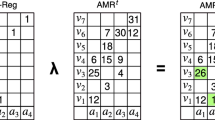Abstract
Willshaw, Buneman and Longuet-Higgins have proposed a nonholographic associative memory model for the brain1. They also criticize the proposal made by myself2 and by Pribram3,4 that the brain would be organized on the holographic principle. They say: “How could the brain Fourier-analyse the incoming signals with sufficient accuracy, and how could it improve on the rather feeble signal to noise ratio of the reconstructed signals ?”.
This is a preview of subscription content, access via your institution
Access options
Subscribe to this journal
Receive 51 print issues and online access
$199.00 per year
only $3.90 per issue
Buy this article
- Purchase on Springer Link
- Instant access to full article PDF
Prices may be subject to local taxes which are calculated during checkout
Similar content being viewed by others
References
Willshaw, D. J., Buneman, O. P., and Longuet-Higgins, H. C., Nature, 222, 960 (1969).
van Heerden, P. J., Applied Optics, 2, 393 (1963).
Pribram, K. H., in Macromolecules and Behavior (edit. by Gaito, J.) (Academic Press, New York, 1966).
Pribram, K. H., Sci. Amer., 220, 73 (1969).
van Heerden, P. J., Applied Optics, 2, 387 (1963).
van Heerden, P. J., The Foundation of Empirical Knowledge, with a Theory of Artificial Intelligence (Wistik, Wassenaar, Netherlands, 1968).
Author information
Authors and Affiliations
Rights and permissions
About this article
Cite this article
VAN HEERDEN, P. Models for the Brain. Nature 225, 177–178 (1970). https://doi.org/10.1038/225177a0
Received:
Issue Date:
DOI: https://doi.org/10.1038/225177a0
This article is cited by
-
Thinking in circuits: toward neurobiological explanation in cognitive neuroscience
Biological Cybernetics (2014)
-
On associative memory
Biological Cybernetics (1980)
-
An algebraic model of an associative noise-like coding memory
Biological Cybernetics (1980)
-
Geometry of binocular vision and a model for stereopsis
Biological Cybernetics (1976)
-
A note on convolution and stable distributions in the nervous system
Biological Cybernetics (1975)
Comments
By submitting a comment you agree to abide by our Terms and Community Guidelines. If you find something abusive or that does not comply with our terms or guidelines please flag it as inappropriate.



